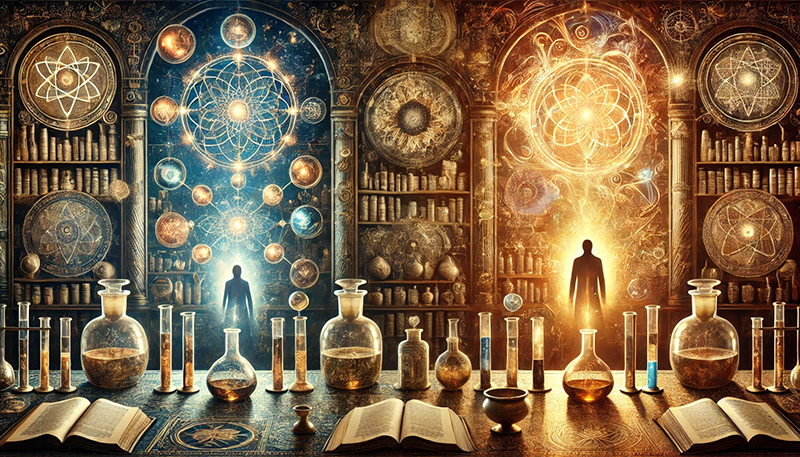Introduction
Spiritual alchemy uses the quest for turning physical base metals into gold as a metaphor for the path of transforming the ‘base’ human soul into the ‘gold’ of enlightenment and our best/highest selves. Rooted in mystical and philosophical teachings, it is the art of transmuting the soul, leading to spiritual enlightenment and inner transformation.
Historical Background
The origins of alchemy date back to ancient Egypt, Greece, and the Islamic world, where it was practiced as both a proto-scientific and spiritual discipline. In the Middle Ages and Renaissance, alchemy flourished in Europe, often interwoven with Christian mysticism, Jewish Kabbalistic teachings, and Islamic alchemical texts. Notable figures in the history of spiritual alchemy include:
- Paracelsus (1493-1541), a Renaissance physician and alchemist, pioneered the concept of spiritual alchemy by integrating alchemical principles with spiritual and medical practices, emphasizing the transformation of the soul and the purification of the spirit as essential components of healing and achieving a deeper understanding of the divine and the cosmos.
- Isaac Newton (1643-1727). Yes, the famous physicist and mathematician. Newton spent more time on alchemy than on physics and math. Newton’s alchemy wasn’t solely focused on practical experiments, however. He also engaged with the philosophical and mystical dimensions of alchemy, exploring the connections between the physical and spiritual worlds. He believed that understanding alchemical processes could reveal deeper truths about the universe and the divine.
- Carl Jung (1875-1961) Originally his student, Jung came to disagree with Freud’s emphasis on sex, and was more interested in the whole human being. Jung wrote extensively about how the medieval alchemical texts metaphorically describe the psychological transformation process in which individuals integrate unconscious elements into consciousness, achieving self-realization and inner wholeness.
The Symbolism of Alchemical Processes
Spiritual alchemy uses the language of physical alchemy — metals, elements, and processes — as symbols for the transformation of the soul. The key processes in spiritual alchemy are often described in a sequence that mirrors the stages of an alchemical operation:
- Calcination: This initial stage involves burning away the ego and attachments, representing the death of the false self. It corresponds to purification through intense introspection and spiritual practice.
- Dissolution: Here, the remnants of the ego are dissolved, signifying the breaking down of rigid beliefs and emotional blockages. This stage fosters a deep sense of humility and openness.
- Separation: The essence of the true self is separated from the dross, akin to discerning the pure from the impure within. It involves recognizing and integrating hidden aspects of the psyche.
- Conjunction: The purified elements are recombined, symbolizing the union of the conscious and unconscious mind. This stage is often associated with mystical experiences and the realization of inner harmony.
- Fermentation: This stage is likened to the death and resurrection of the soul, where the old self dies, and a new, enlightened self is born. It often includes a period of inner darkness, followed by profound spiritual insight.
- Distillation: Further purification occurs, refining the soul to its highest state. It represents the continuous process of spiritual evolution and deepening wisdom.
- Coagulation: The final stage signifies the solidification of spiritual truths into one’s being, achieving the ‘Philosopher’s Stone’—a state of enlightenment and unshakeable inner peace.
The Inner Work: A Path of Transformation
Spiritual alchemy emphasizes the importance of ‘inner work,’ which involves self-examination, meditation, and the cultivation of virtues such as love, compassion, and humility. This inner work is akin to the alchemist’s labor in the laboratory, requiring patience, perseverance, and dedication.
One of the central tenets of spiritual alchemy is the idea that transformation begins within. By transmuting the ‘base metals’ of ignorance, selfishness, and negativity into the ‘gold’ of wisdom, selflessness, and love, individuals can achieve a state of spiritual purity and divine connection. This process is not linear or straightforward; it involves cycles of growth, decay, and rebirth, reflecting the alchemical principle of transformation through opposites.
The Psychological Perspective
Carl Jung, a pioneer in analytical psychology, explored the symbolic language of alchemy extensively. He viewed alchemy as a metaphor for the individuation process, where the alchemist’s quest mirrors the psychological journey towards wholeness. According to Jung, the various stages of alchemy represent the integration of the unconscious with the conscious mind, leading to the realization of the Self.
In Jungian psychology, the alchemical processes are seen as stages of personal growth and self-realization. For example, the ‘nigredo’ or blackening phase represents the encounter with the shadow — the hidden, often repressed aspects of the psyche. Through this confrontation, individuals can integrate these aspects, achieving a greater sense of self-awareness and balance.
The Modern Relevance of Spiritual Alchemy
In today’s world, spiritual alchemy offers a guide for those seeking inner transformation and enlightenment. Its teachings encourage individuals to look beyond material pursuits and focus on the alchemical gold within — qualities such as compassion, wisdom, and inner peace.
The process of spiritual alchemy is deeply personal, yet universally applicable. It invites each of us to embark on our unique journey of transformation, discovering the divine essence within themselves and the interconnectedness of all life. Through the symbolic language of alchemy, which transcends and includes religion, seekers can find insights and practices to support their spiritual growth.



Leave a Reply